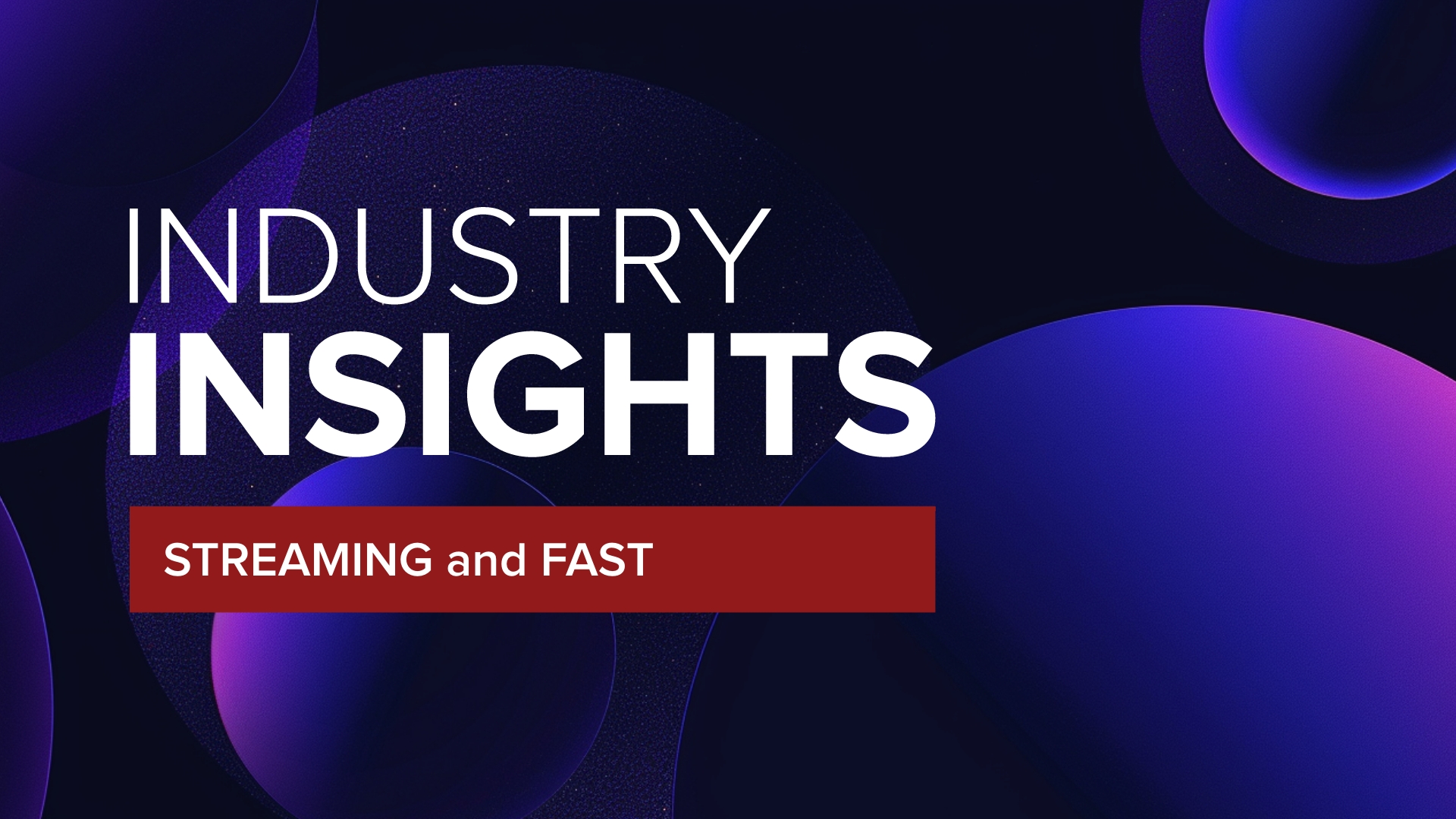Industry Insights: Local broadcasters embracing FAST and forging new partnerships

Subscribe to NCS for the latest news, project case studies and product announcements in broadcast technology, creative design and engineering delivered to your inbox.
In the evolving landscape of broadcast technology, free ad-supported streaming television (FAST) is rapidly becoming a focal point for industry discussions. As part of our Industry Insights series, this roundtable gathers a diverse group of broadcast vendors and suppliers to delve into the integration and implications of FAST within traditional broadcasting.
Part two of this series explores the shift towards FAST and its implications for traditional broadcasters, the transformation of TV viewing habits and the critical role of partnerships and collaborations in the industry.
Participants discuss how embracing FAST is not just an option but a necessity for broadcasters aiming to remain relevant in an era where audience preferences lean heavily towards on-demand content.
Key takeaways from the Industry Insights roundtable
- Traditional broadcasters must adopt FAST and streaming to survive, enabling them to reach a broader audience and adapt to consumer preferences for on-demand content. This transition necessitates re-engineering their infrastructures for agility in launching new delivery services.
- FAST platforms are altering traditional TV viewing habits by offering premium content for free, attracting a growing audience base, including sports rights holders and cord cutters. This shift reflects a broader industry trend towards digital-first, consumer-centric media consumption.
- Partnerships and collaborations are critical in the FAST industry, relying on advanced technologies including AI. These alliances enable the sharing of unique product specialties, distribution for distinctive content, and support for ad networks to maximize advertising revenues.
- The evolution of FAST services is anticipated to draw in technology vendors with a track record in delivering broadcast reliability, video quality, and an enhanced user experience, broadening the scope of FAST beyond niche players and into mainstream adoption.
How do you see traditional broadcasters, such as local TV stations, further embracing FAST and streaming?
Medhat Ali, director, VM Cloud: They have to embrace it to survive. It allows them to reach a wider audience, adapting to viewer preferences for on-demand content. This imperative to adopt the latest delivery techniques is driving broadcasters and content owners to re-engineer their infrastructures, building platforms on virtualised software which gives the needed agility to add new delivery services quickly and easily.
Venugopal Iyengar, COO for digital, Planetcast: FAST and streaming are of greatest use to traditional broadcasters as a means to extend their reach. For instance, many younger viewers exclusively view content through streaming on mobile devices, and traditional broadcasters have the opportunity to entice them by providing content for their platform of choice. FAST and streaming can offer a great deal to local broadcasters. Enabling the super-serving of their audience and offering monetizable hyper-local OTT services.
John Wastcoat, SVP of business development, Zixi: Traditional broadcasters are under increasing pressure to sustain and enhance audience engagement, given that the conventional linear content delivery method is falling short in capturing the attention of the new generation of viewers. Beyond traditional distribution channels, incorporating streaming alternatives and customizing content to boost engagement are strategies they can adopt to embrace change and remain relevant in this evolving landscape. This requires a shift towards more flexible and personalized content delivery approaches to connect with next generation of viewers.
Paul Briscoe, chief architect, TAG Video Systems: In my opinion, FAST is the thing that can offer the strongest lifeline to the broadcast industries. Enabling the retention of their existing broadcast and revenue models, FAST distribution opens the door to delivering more streams and relevant advertising to a new audience demographic.
Anupama Anantharaman, VP of product management, Interra: Not only are broadcasters incorporating over-the-top (OTT) streaming into their services, but they are also diversifying their content by developing more distinctive and unique programming. And to boost revenues, they are exploring methods to seamlessly integrate advertisements across both traditional broadcast and OTT streaming platforms, while investing in data and analytics tools to enhance personalization and improve the viewing experience.
Dave Dembowski, SVP of global sales, Operative: Traditional broadcasters will take time to move completely to streaming, but during that transition, they need to be able to sell products that appeal to advertisers who also work with pure play streamers, social giants and more. Traditional broadcasters are seeing more advertiser customers who want to buy and sell in a modern way. This means they need to offer self-service media buying, targeting and flexible delivery across their product catalog.
Greg Morrow, GM of ViewNexa, Bitcentral: One of the most recent developments we have seen from our customers is “hyper-local” sports programming such as high school, junior college, and local second-tier professional leagues. These have historically been underserved audiences and are getting increasing amounts of traffic and creating additional revenue streams and sponsorship opportunities for these stations. It is exciting as live local content draws huge tune-in times, even drawing in audiences outside the local community.
Srini KA, co-founder and CRO, Amagi: We have seen many broadcasters, especially news, using Amagi products to launch the same or variant channels in FAST platforms. We expect this to continue in sports, news, and local segments in 2024. News channels continue to dominate viewership across geographies with localized content getting traction in FAST.
In what ways is FAST altering traditional TV viewing habits?
Ahmed Swidan, director, Ateme: FAST platforms today offer premium content, and I expect they will continue to gain market share in the coming years. Indeed, FAST is attracting a growing range of players and viewers: Sports rights holders are leveraging it to increase their reach, while many cord cutters are heading to FAST to watch content.
Yoann Hinard, COO, Witbe: FAST offers the same comforting feeling as traditional cable TV, with its set schedule and unskippable ads. And since it’s being pushed through most smart TVs and streaming media boxes, viewers are increasingly discovering and enjoying it. With many customers already “cutting-the-cord” and canceling their cable TV packages, having a free and easy streaming alternative will only accelerate that trend.
Paolo Cuttorelli, SVP of global sales, Evergent: Although the lean-back, ad-based viewing experience feels distinctly familiar to traditional linear TV, the growth of FAST services reflects a broader industry trend towards digital-first, consumer-centric media consumption. Viewers now have access to more varied and niche content experiences. Consumers have a much deeper level of control over the content they choose to watch today, giving media companies and advertisers a wealth of actionable, valuable data to tap into.
Paul Calleja, CEO, GlobalM: FAST and streaming providers are under increasing pressure to offer adaptable and user-friendly features such as on-demand and personalized content experiences. This necessitates cloud innovation throughout the content delivery ecosystem — not just where content meets the consumer. A network that leverages the cloud for contribution allows for more flexibility and control further along the delivery chain.
Gatis Gailis, CEO, Veset: Advertising for traditional broadcasted content is a scheduled break from content, whereas with the changing landscape of FAST channels, this no longer has to be the case. FAST channels are creating an industry where content is on-demand at all times, viewed almost entirely by one consumer per one account with different habits and behaviors to other viewers. This industry-shaking alteration in the way that we consume content has drastically changed viewing habits, creating a landscape where personalization, monetization and content demand is at an all-time high.
Paul Briscoe, chief architect, TAG Video Systems: FAST does not necessarily alter traditional viewing habits, although OTT inherently offers the ability to pause, rewind, fast forward, and so on — providing convenience not natively available in broadcast. Combined with the ability to deliver to any platform in appropriate quality and with a handoff to other devices, this alone offers entirely new ways to consume.
Thomas Kramer, VP of strategy, MainConcept: It is not so much FAST altering traditional TV viewing habits, more a change is being seen in streaming viewing habits. The growth of FAST has led almost all the major streamers to add ad-supported options to their platforms. With a constant stream of content accessed from anywhere, anytime, the younger generation are starting to learn the value of the comfort break, something that traditional TV offered. The choice and availability FAST platforms afford makes it increasingly attractive to audiences that grew up watching traditional TV.
Dave Dembowski, SVP of global sales, Operative: FAST is part of a larger movement of on-demand content that is also becoming more interactive, with better targeting than ever. Consumers and advertisers are embracing these elements, which they are also used to on web and mobile channels.
Greg Morrow, GM of ViewNexa, Bitcentral: FAST has changed how we watch TV because it combines the beauty of traditional linear broadcasts within the streaming landscape. In today’s market, FAST channels offer a free alternative to subscription platforms and provide an excellent opportunity to drive revenue on existing content libraries. We have also seen an increase in niche channels, including sports and special interest content; these channels include pickleball, billiards and chess to name a few.
Allan Nicholson, head of advertising solutions, Harmonic: There’s lots of research out there indicating that in many households watching large screens through free-to-air (FTA) broadcast services is frequently considered a secondary screen activity. As smart TVs and FAST channels become increasingly prevalent in connected TV (CTV) settings, the appeal of FAST as a viewing medium is going to grow and become more engaging due to its enhanced ability to target households and monitor user engagements.
Srini KA, co-founder and CRO, Amagi: FAST is accelerating cord-cutting decisions. With Streaming TV (Smart TV & devices) getting widely adopted, more audiences are getting attracted to FAST. As more genres enter the market, we expect the adoption trend to gain further traction. A survey conducted by Amagi echoed that 61% of viewers don’t mind seeing ads in case of free good quality content.
How critical are partnerships and collaborations in the FAST industry?
Josh Pine, CRO, XL8: In the FAST world, partnerships and collaborations are absolutely critical. No pun intended, but the FAST world is moving very fast, and is relying on the most state of the art technologies, many of which include complex AI created features. AI is both expensive to develop, and AI companies are fragmented into their own unique product specialties. There’s no time to “reinvent the wheel” so to speak, and it would be too expensive to re-develop or copy existing technology. So, partnerships and collaborations are must to be successful.
Venugopal Iyengar, COO for digital, Planetcast: Partnerships in FAST are certainly as critical as any other business. For instance, partnerships with streaming platforms for exclusivity can be very mutually beneficial. What’s more, partnerships with OEM vendors provide essential distribution for distinctive content. Support for ad networks and delivery tech provides the framework to maximize advertising revenues.
Ahmed Swidan, director, Ateme: Effective collaboration between content owners and FAST platforms is essential for the success of FAST. Typically, this entails a revenue-sharing arrangement, requiring the implementation of technical solutions to manage revenue distribution and inventory routing.
Paolo Cuttorelli, SVP of global sales, Evergent: Strategic partnerships are becoming increasingly critical in the wider streaming industry, especially as the market becomes more saturated. We’re seeing an accelerated trend towards aggregation as operators look to bundle their own and other streaming services — including FAST platforms — to increase subscriber retention and enhance average revenue per user. This is becoming essential for unlocking growth in new markets while securing stickier, more secure revenue streams.
Paul Calleja, CEO, GlobalM: From a video contribution perspective, interoperability is crucial and IP solutions should be compatible with any SRT, RIST or RTMP compliant encoder or decoder. Hybrid satellite and IP models can balance capacity, manage budgets, and optimize latency, so using a combination of methods for the right use case will give you the best of both worlds for collaborative contribution.
Gatis Gailis, CEO, Veset: In light of introducing system integrations into our cloud playout solutions, partnerships and collaborations with other cloud providers and vendors is an essential practice in the ever-changing cloud playout industry. By working with external providers to integrate new solutions and systems, cloud playout providers can create a re-imagined and evolved approach to meeting consumer demand. Integrating our technologies with external organizations such as AWS allows for us, as an organization, to introduce exciting new monetization and personalization prospects in the form of ad services and playout efficiency.
Anupama Anantharaman, VP of product management, Interra: Establishing a profitable and sustainable business model in the FAST industry requires strategic collaborations with companies specializing in data and analytics, particularly ad-related data — given the increased popularity of FAST. In addition, partnerships with content creators and distributors are essential for building a competitive content library, while teaming up with advertisers and industry associations fosters the innovation needed to stay ahead of the competition.
Rick Young, SVP and head of global products, LTN: Traditional distribution models are shifting, and as audiences migrate to FAST channels, media brands need partners with innovative technology, comprehensive skill sets, and a deep understanding of FAST distribution. The right partner will enable media companies to embrace changes and smoothly transition to new technologies and business models. In the face of increased complexity, a more challenging business climate, and emerging technology trends, partnerships have never been more critical, as they deliver greater reliability, scale, and efficiency.
Eric Black, CTO/GM of media, Edgio: Media organizations are increasingly embracing a managed services approach to achieve more flexibility and streamline their costs, especially when it comes to quickly launching new business models such as FAST. Partnering with a managed services provider makes sense from a commercial and technology perspective, giving media companies quick and seamless access to pre-integrated, best-in-breed partner solutions to handle all of the complexities of assembling custom streaming workflows for FAST.
Explore more from this roundtable
Subscribe to NCS for the latest news, project case studies and product announcements in broadcast technology, creative design and engineering delivered to your inbox.








tags
Ahmed Swidan, Allan Nicholson, Amagi, Anupama Anantharaman, ATEME, Bitcentral, Broadpeak, Dave Dembowski, Edgio, Eric Black, Evergent, Free Ad-Supported Streaming Television (FAST), Gatis Gailis, GlobalM, Greg Morrow, Harmonic, Interra Systems, John Wastcoat, Josh Pine, KA Srinivasan, LTN, MainConcept, Medhat Ali, Olivier Karra, Operative, Paolo Cuttorelli, Paul Briscoe, Paul Calleja, Planetcast International, Rick Young, strategic partnership, TAG Video Systems, Thomas Kramer, Venugopal Iyengar, Veset, VM Cloud, Witbe, XL8, Yoann Hinard, Zixi
categories
Heroes, Industry Insights, Streaming, Voices